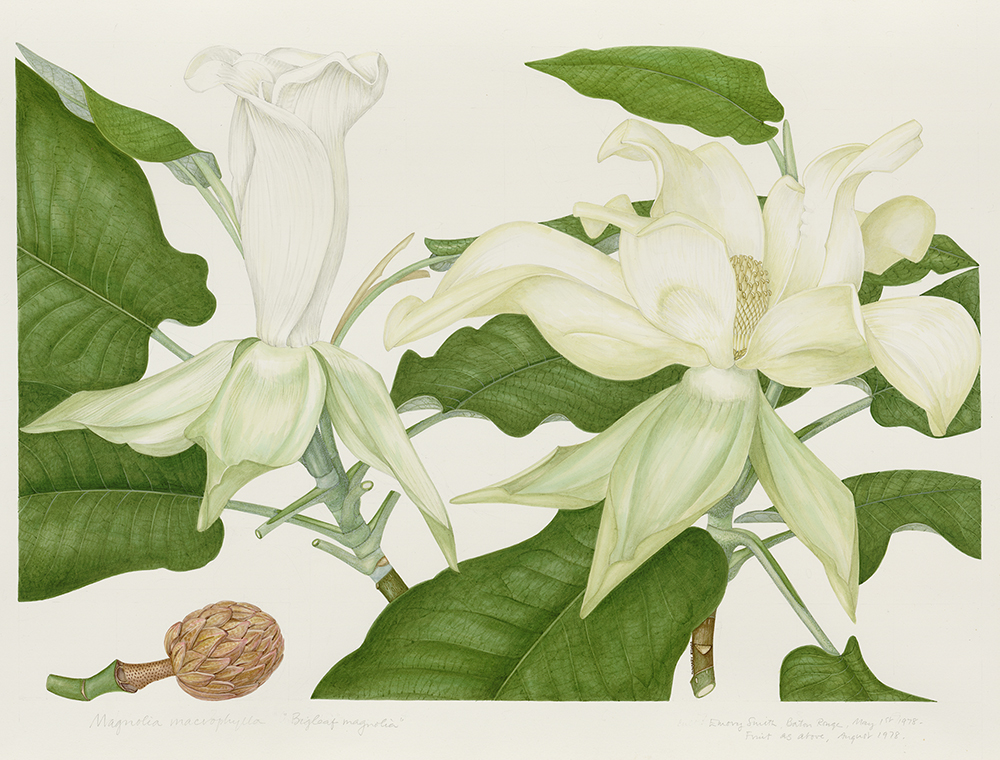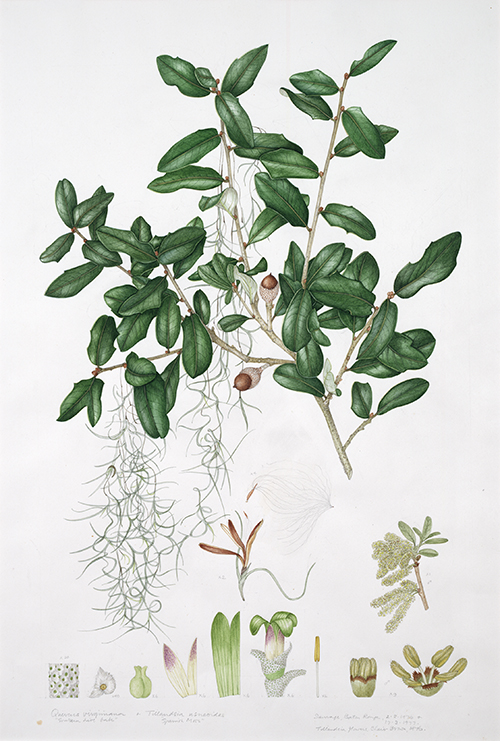Remembering Margaret Stones

University Archives in LSU's Special Collections." data-title="Margaret Stones at work in the LSU Faculty Club, late 1970s. From University Archives in LSU's Special Collections."/> News of the death of internationally renowned botanical artist Margaret Stones on December 26, 2018 in her native Australia at age 98 sent ripples of grateful memories of her special relationship with LSU, the LSU Libraries, and Louisiana, spanning several decades. A major part of her life's work is among the most treasured holdings of LSU Libraries' Special Collections in the E. A. McIlhenny Natural History Collection at Hill Memorial Library. Described by a former curator as a collection of botanical art unmatched in any other state, the over two hundred exquisite watercolor drawings of Louisiana native plants created by Margaret Stones from 1976 to 1989 are known as the Native Flora of Louisiana Collection. The drawings, which combine detailed scientific accuracy with exceptional artistic beauty, constitute a remarkable record of Louisiana's varied plant life. The Louisiana flora project was the third and final multiyear endeavor Stones undertook during her storied professional career. Born in 1920 in Colac, Australia, Margaret Stones studied industrial art at Swinburne Technical College in Melbourne on a three-year scholarship, then attended night classes at the National Gallery of Victoria Art School while working as a commercial artist. With the outbreak of World War II, Stones entered nursing training, but in 1945 became a hospital patient herself after contracting pulmonary tuberculosis. Confined to bed for over a year, she occupied her time by making drawings of wildflowers brought to her by visitors. The drawings impressed her physician, and this led to contacts in Melbourne and resulted in Stones' first solo exhibition, as well as opportunities to attend botany lectures at the University of Melbourne and participate in botanical expeditions documenting Australian flora.

Magnolia Macrophylla, or Big Leaf Magnolia, from Stones' Native Flora of Louisiana." data-title="Magnolia Macrophylla, or Big Leaf Magnolia, from Stones' Native Flora of Louisiana."/> Stones left Australia for England in 1951 to further develop her skills in botanical illustration, taking up employment as a freelance artist at the Royal Botanic Gardens, Kew, where she remained until 2002. From 1958 to 1983, she was the principal contributing artist to Curtis’s Botanical Magazine, in which over 400 drawings by her were published. Valued by botanists for its scientific correctness, Stones’ work during her years at Kew included illustrations for scientific monographs as well as other projects. Her second major body of work, commissioned by Lord Talbot de Malahide, was issued from 1967 to 1978 in six volumes in The Endemic Flora of Tasmania, considered one of the most significant botanical publications of the 20th century. While at work on the Tasmanian flora, Stones received a visitor from Louisiana—an encounter that would lead into what the artist later called “the ten happiest years” of her life. That visitor, LSU professor emerita of theater Gresdna Doty, on sabbatical in London at the time, was the catalyst that brought Stones to work in a part of the world unfamiliar to her until then. Doty proposed to Chancellor Paul Murrill that LSU commission Margaret Stones to create a portfolio of drawings of Louisiana native plants to commemorate the bicentennial of the United States – and LSU’s 50th year at its present campus – in 1976. With strong support from Murrill and others, private funds were raised to commission six watercolor drawings from Stones, who was immediately intrigued by the variety and beauty of Louisiana’s flora. Those first six watercolors were so enthusiastically received by the LSU community that Murrill offered Stones an expanded commission for 200 drawings, to be completed over ten years.

Quercus Virginiana, or the Southern Live Oak, from Native Flora of Louisiana." data-title="Quercus Virginiana, or the Southern Live Oak, from Native Flora of Louisiana."/> A statewide committee solicited sponsorship from individuals and corporations, and Lowell Urbatsch of LSU’s botany faculty became the project’s principal scientific advisor. Urbatsch coordinated the selection and collection of plant specimens from throughout Louisiana for Stones to draw, and these were subsequently deposited in the LSU Herbarium as a permanent scientific record of the project, complementing the beautiful drawings that entered the Libraries’ McIlhenny Collection. Since she worked only from live specimens Stones made regular trips to Baton Rouge each year and worked in a suite provided for her in the LSU Faculty Club. She often joined in local plant collecting excursions, making lasting friendships with some of the participants. The Louisiana flora project with Margaret Stones not only generated considerable public interest, but also expanded botanical knowledge by documenting a number of rare and endangered plants never illustrated before. In recognition of her outstanding work, LSU awarded Stones an honorary doctorate in 1986 and a University Medal in 1992. LSU Press first published the Stones drawings in book form in 1991, in Flora of Louisiana. Selected drawings from the Louisiana flora collection have been exhibited in Hill Memorial Library, as well as other venues in Louisiana. Some of Stones’ watercolors also have been loaned for exhibitions at the Smithsonian in Washington, DC, and to museums in England, Scotland, and Australia. The drawings in the Native Flora of Louisiana Collection are a marvelous record of the state’s natural heritage as well as an artistic treasure, which community groups, LSU visitors, and classes in botany, landscape architecture, and art are welcomed into Hill Memorial Library to view by appointment. In November 2018, LSU Press issued a much-anticipated full-color folio edition of the Stones watercolors under the title Native Flora of Louisiana. Margaret Stones received a copy of the new book before her death, and was able to enjoy revisiting those ten happiest years of her life during which she worked on the Louisiana drawings. It was surely a gratifying end to her long and amazing journey. There is a sampling of Ms. Stones’ work for display in the Hill Memorial Library’s lecture hall in commemoration of her passing. Please stop by to see a small part of her legacy and remember her full and productive life. The exhibition will run through the end of February 2019.
